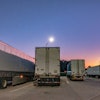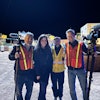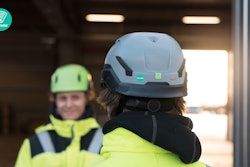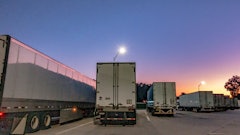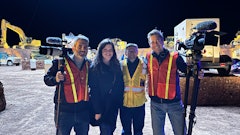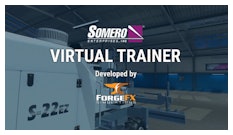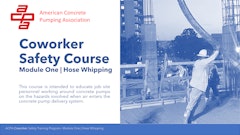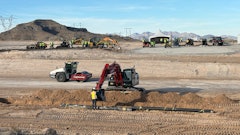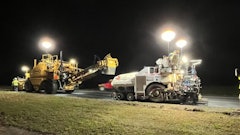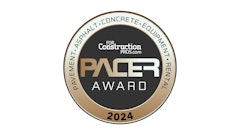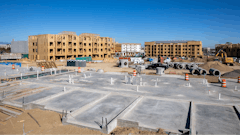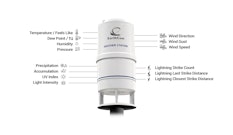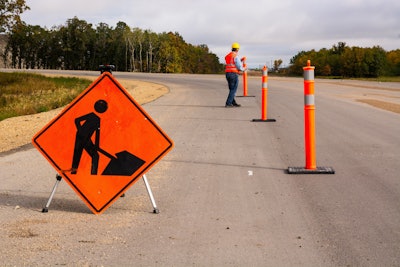
Road construction projects come with a unique set of risks—for those who work on them and those who drive through them.
With narrowed lanes, increased traffic, and the prevalence of distracted drivers, the risk of accidents in work zones is significantly heightened. Workers can face fast-moving vehicles, heavy machinery, and harsh weather conditions. And drivers have to navigate sudden lane shifts, reduced speeds, and unexpected obstacles. Given the dangerous conditions, work zones can quickly become deadly.
In 2022, 891 people were killed and 37,701 injured in work zone crashes, according to the National Safety Council (NSC). Drivers caused the majority of incidents—those engaged in construction activities and those traveling through work zones, according to the NSC.
Bottom line—if proper precautions aren’t taken, it can put your workers and motorists at risk.
Here are a few essential safety tips you should implement to help protect your employees and your business.
Establish A Proper Work Zone
Minimize risk by creating a well-organized work zone. Establish a physical separation between traffic and your work area. Inhibit traffic movement as little as possible.
Place signage, traffic cones, barrels, and barricades to guide drivers, bicyclists, and pedestrians safely away from your workers. You can also refer to the Federal Highway Administration’s Manual on Uniform Traffic Control Devices to help establish a safe environment. Inspect your traffic control elements day and night and make modifications when necessary.
Provide High-Visibility Apparel
There’s a lot going on in work zones. That’s why you need to make it easy for drivers to spot your workers amid the chaos.
Provide high-visibility clothing, such as reflective vests, helmets, and other gear to help ensure workers aren’t just visible—they need to stand out. This is especially important during low-light conditions or projects conducted at night.
Follow A Traffic Plan
Work with local and state entities to develop a traffic control plan and keep the public well informed. If at all possible, create a detour to keep heavy traffic away from your site. If it’s not feasible to provide an alternative route, ensure barriers are clear, speed limit signs are prominent, and workers are trained in traffic safety protocols.
Spotters and flaggers can also help guide heavy machinery operators and manage traffic flow through your work zone, directing vehicles to slow down or stop when necessary.
If possible, work when traffic is lighter. Nighttime or early morning shifts may provide a safer environment for your workers.
Be Aware Of Dangerous Weather Conditions
The number of construction projects typically hits a peak in the summer. That means workers have to battle all kinds of weather, such as intense heat, humidity, rain, or severe storms.
These types of weather conditions can have a major impact on your work zones and employees. Be proactive and monitor the weather forecast to help you plan ahead. If severe weather develops, have a contingency plan in place to halt work and implement safety measures.
When dealing with extreme heat, The Federal Emergency Management Agency (FEMA) recommends adjusting your work schedule to take place early in the day or late in the afternoon. It also recommends that you train your employees to spot the signs of heat stress so they can respond quickly.
Overall, ensure workers have easy access to water, shade, and shelter—anything that can help keep them safe in the elements.
Plan For The Future With The Right Insurance Policies
Given the heightened risks of road construction projects, having comprehensive insurance coverage can help you protect your workers and your business. Here are some coverage options that could work for your business:
- Workers’ compensation insurance provides coverage for employees injured on the job. It covers medical bills, rehabilitation costs, and a portion of lost wages. It can also help shield employers from lawsuits related to the injuries.
- General liability insurance protects your business against claims of bodily injury or property damage that occur due to your operations.
- Commercial auto insurance provides coverage for damage to vehicles you use to haul materials or control traffic. It can also cover medical expenses for injuries caused by your vehicles, and liability for accidents involving company-owned vehicles.
- Builder’s risk insurance covers damage to property and materials during the construction process incurred from events like fires, vandalism, theft, or natural disasters.
- Professional liability insurance is also known as errors and omissions (E&O) insurance. It can help protect against claims of negligence or mistakes in the planning or execution of projects.
The unique risks of work zones demand diligent safety practices that require a proactive approach. The well-being of workers and motorists hinges on your preparation and execution. Help prevent incidents by staying vigilant and adhering to your established safety protocols.
These four elements aren’t meant to be a complete list. It’s important to evaluate your business and determine what makes the most sense for your safety program. As always, reach out to your insurer or local experts for a plan specific to your business.


